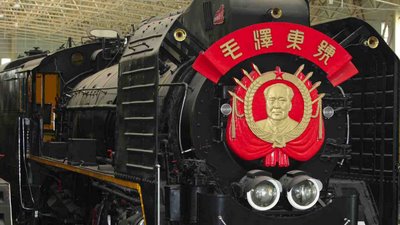Chinese Railroads
Rail transport is the most commonly used mode of long-distance transportation in the People's Republic of China. Almost all rail operations are handled by the Ministry of Railways, which is part of the State Council of the People's Republic of China. By the end of 2009, the operating rail network traverses the length and breadth of the country, covering a total length of 86,000 km (53,438 mi), making only the rail networks in the United States and Russia larger in size. As of 2008, Chinese Railway owned about 584,961 wagons, 43,215 coaches and 18,437 locomotives and ran more than 36,300 trains daily, including about 3000 passenger trains and 33,300 freight trains. The network today serves all provinces, with the exception of the special administrative region of Macau.
As of October 2008, the Chinese State Council approved a new CNY 2 trillion (US$ 292 billion) railway investment plan to take it up to 2020. The scheme extends China's previously announced railway building program, which was allocated CNY 1.25 trillion (US$ 182 billion) in the Eleventh Five-Year Plan for 2006 to 2010. As a result of the increased investment, the country's railway network is expected to grow from 78,000 km at the end of 2007 to 100,000 km by the end of 2010 and ultimately 120,000 km by 2020. Growth in freight transport is thought to be one of the drivers behind the increased focus on rail, and the need to increase capacity to meet rising demand.
Current network
China maintains about twenty principal domestic railway routes with a total length of 78,000 km by the end of 2007. Total length was increased to 86,000 km by the end of 2009.
Total: 78,000 km (network length). The total track length is 154,600km.
Standard gauge: 79,685 km 1,435 mm (4 ft 8 1⁄2 in) gauge (2008)
Metre gauge: 466 km 1,000 mm (3 ft 3 3⁄8 in) (Yunnan-Vietnam Railway)
Narrow gauge: 3,600 km 750 mm (2 ft 5 1⁄2 in) gauge local industrial lines (1998 est.)
Main article: Narrow gauge railways in China
Electrified: 27,500 km, 34.5% electrified (2008)
Double track: 29,000 km (not included in total) (2008)
Train speed limits
China has increased the allowed top speed for trains six times: in April 1997, October 1998, October 2000, November 2001, April 2004, and April 18, 2007. In the 1997 speedup, the top speed of passenger trains on some of the main lines was increased to 140 km/h. During the following speedups top speeds were increased to 160 km/h on some lines and up to 250 km/h. During the 2007 speedup, the top speeds reached 200 km/h on 6,003 km tracks of main lines such as Jinghu Railway, Jingha Railway, and Jingguang Railway. On 848 km tracks the top speeds reached 250 km/h, most of which were on the Qinshen Passenger Railway.Another 14,000 km tracks had a top speed limit of 160 km/h and an extra 22,000 km tracks had a 120 km/h limit. In addition, during this speedup, the heavy-haul freight transportation speed limit was also boosted to 120 km/h. This speedup was expected to boost passenger and cargo capacity by 18 percent and 12 percent respectively. The newly built Beijing-Tianjin high-speed rail has a top speed of 350 km/h.
Passenger transport
Rail is one of the principal means of transport in China, with over 1.3 billion railway trips taken in 2007 and 1.4 billion estimated for 2008. The Spring Festival Travel Season is the peak railway travel season of the year. In 2008, 1.456 billion people travelled 772.8 billion km by rail.
During the three weeklong holidays in China, known as "Golden Week", demand for tickets increases dramatically due to many migrant workers returning home and others using the time to travel the country. The holidays are the week starting May 1st and October 1st and the week around Chinese New Year, also known as the Chunyun season.
Even though the duration of the May holidays was shortened in 2009, the holiday traffic remained strong, with the record of 6.54 million passengers carried over the Chinese rail network on May 1, 2009.
High-speed rail
High-speed rail services were introduced in 2007 and are operated using CRH trains. These run on existing lines that have been upgraded to speeds of up to 250km/h and on dedicated high speed track up to 350 km/h
train, fire + vehicle)
New York and Chicago Railroad


